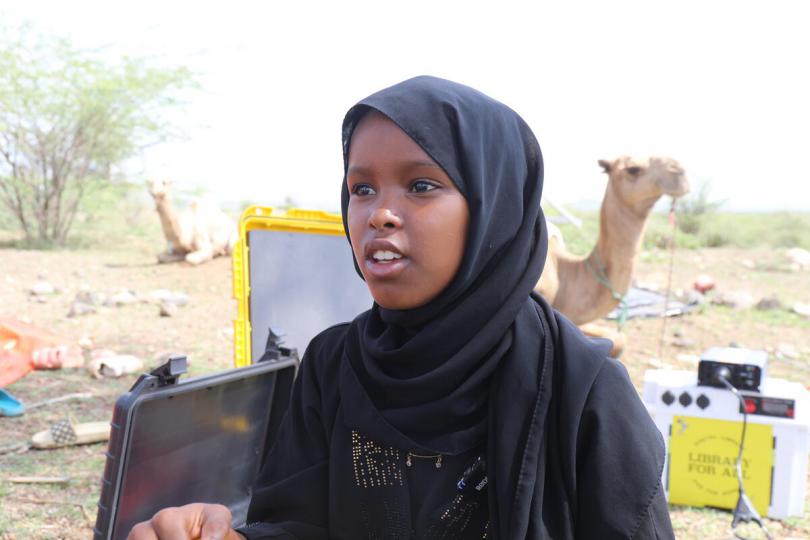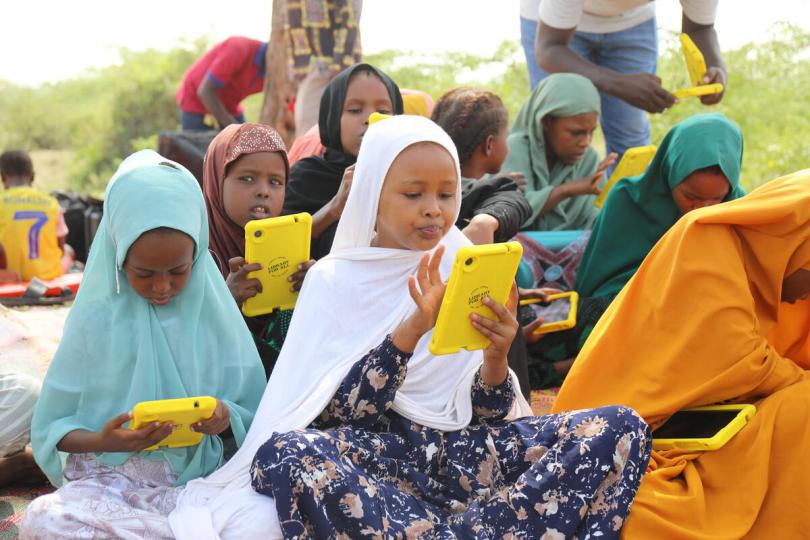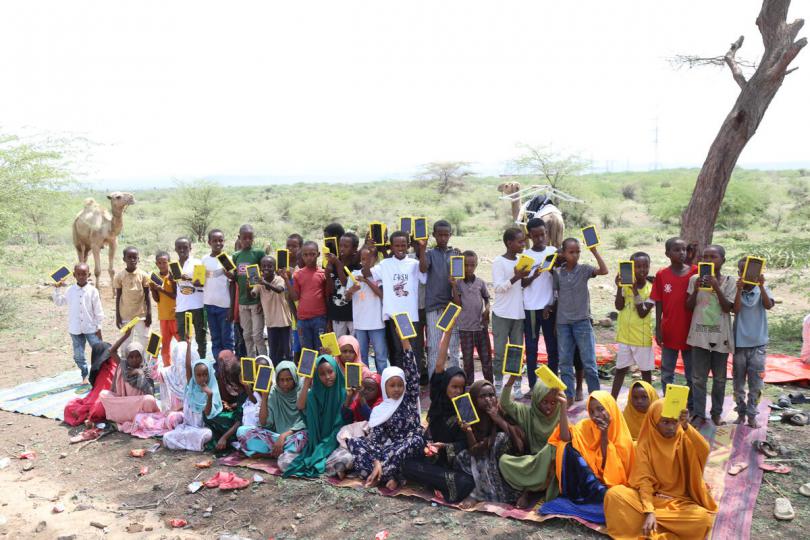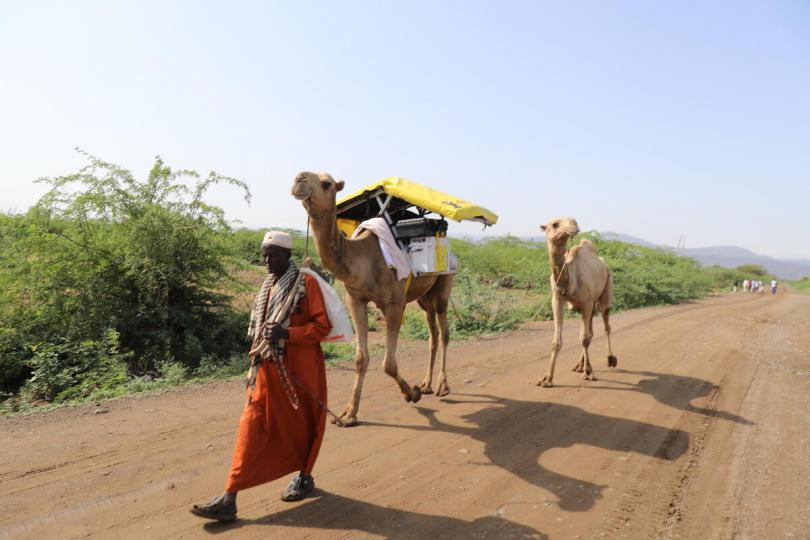The digitalized mobile camel library reaches remote villages in Somali region of Ethiopia

Summary
Nima, an 11-year-old student, has recently been promoted to third grade in her school in the Somali region of Ethiopia. She was one of the best-performing students in her class, achieving the highest scores and ranking second overall during this academic year. Somali language is her favorite subject, and reading has been her greatest passion at school.
A four-legged digital camel library continues to supply children in remote villages in the Somali region with storybooks to read. The camel library, which once carried paper books to children in the desert, has been recently transformed into a digital library. It now provides children Somali folk storybooks loaded into tablets, hence offering them an opportunity to access reading material that helps improve their reading and writing skills. This initiative is especially valuable for children in remote and inaccessible villages.
Nima and the other children in her community join the digital mobile camel library which provides them with tablets containing various children’s storybooks. Even during spring school breaks, the library continues its service, allowing children to access reading materials that help them prepare for the next academic year. The camel library follows a schedule, visiting each village once a month and staying for a total of three days and nights before moving to another location. During this time, children can borrow the tablets and read the stories installed on them. The camel library visits at least five villages in a given month.

Nima’s Story in her own words (quotes)
“My name is Nima. I am an 11-year-old third-grade student at a nearby primary school. I live with my parents and five siblings here in the Somali region. My favorite subject in class is the Somali language. This academic year, I achieved the second-best grade in my class and was promoted to third grade.”
“About five months ago, we first learned about the camel library from our teacher and the librarian. At that time, we were a little surprised because in the past, we had only seen camels in our area carrying heavy goods from one place to another. We never expected that camels could also transport books and serve as a library.”
“At first, the tablets were significantly challenging. I was unsure how to use them or where to begin. However, the librarians’ kindness and patience guided me through the process. Thanks to their assistance, my ability to navigate the tablet and explore its icons has greatly improved. No longer lost in the digital landscape, I now explore the virtual library with ease. Every touch reveals a new section.”
“Now, the camel library has become one of my favorite places to visit. I eagerly await the arrival of the camel with its tablet, as it brings a wealth of stories for me to read. I enjoy the beautiful pictures in the children’s story on the tablet; they help me better understand the story. The story about the camel is one of my favorites to read. While reading the story, I learned that camels could survive for more than a month without water and can carry bulky goods, making them the strongest and most enduring animals on the planet.”
“Most of the stories on the tablet are both fun and educational. After joining the camel library, my reading ability has greatly improved.”
“Before the camel library arrived, we used to read only the textbooks we received from school. Now, thanks to the camel library, we have access to a wealth of reading materials. The fascinating stories on the tablet provided by the camel library hold our attention. In the short time since the library arrived in our village, I’ve noticed significant improvements in my reading skills. I am confident that with continued access to the camel library, my reading abilities will surpass their current level.”
“Despite schools being closed for the spring break, the camel continues to visit our village, bringing tablets containing stories. I find joy in reading these stories, which have significantly enhanced my reading ability. I recognize that consistent reading will further improve my skills and better prepare me for the upcoming academic year.”
"We are immensely grateful to Save the Children for introducing the camel library to our village. However, the current three-day visit feels insufficient to fully explore all the stories on the tablet. We sincerely hope that the camel could stay longer, allowing us more time to read and enjoy the literary treasures it brings."

Project background:
Save the Children through funding support of Norton Rose Fulbright and the World Library, has expanded the solar-powered digital camel library to additional villages in the Somali region of Ethiopia. In addition to the district where it was previously operational, the newly launched digital camel library now serves two more districts, hence reaching over 3,500 more children. These children can now enjoy Somali folklore and enhance their reading skills through supplementary materials. The initiative fosters a love for reading by providing access to stories in respective own cultures and languages. Thanks to solar-powered camel libraries equipped with tablets , this educational transformation is possible even in the most remote and hard-to-reach areas.
In 2021, Save the Children received the first 42 tablets containing Somali folk stories for children in the Erer area. This revolutionized the camel library initiative. Instead of carrying paper books in a wooden box, the camel now carries a library for all spark kit filled with tablets pre-loaded with hundreds of children’s books prepared in the local language. These are culturally appropriate books that are ready to read. The tablets are charged by the abundant sun available in the region through specially installed solar panels. Everything is packed together on a camel-friendly harness uniquely developed for this project. This shows that there are no barriers to providing advanced quality reading materials that support children’s education and enable them to develop reading skills.
The library has recently expanded into two additional districts in the Somali Region. The number of digital tablet computers we received has grown to 840, benefiting over 3,500 children by providing access to reading books.
A typical day for the camel library begins with loading of tablet computers, solar panels, batteries, and other library materials into the box and loading them on the camel back. The caravan then moves to designated areas. One of the camels carries a box filled with tablet computers, a plastic sheet, and mats. The second camel serves as a backup in case the other camel encounters any issues. During each three-day stay at a site, the camels are released to graze and are checked for signs of illness or disease by the herder. A single camel caravan is expected to reach up to five primary schools in clusters.






